It takes newborn puppies up to two weeks to open their eyes. But once they do, you’ll notice that their eyes are a soft crystal blue. Puppies born with blue eyes are certainly cute, but most mature dogs end up with brown eyes. So why does puppy eye color change?
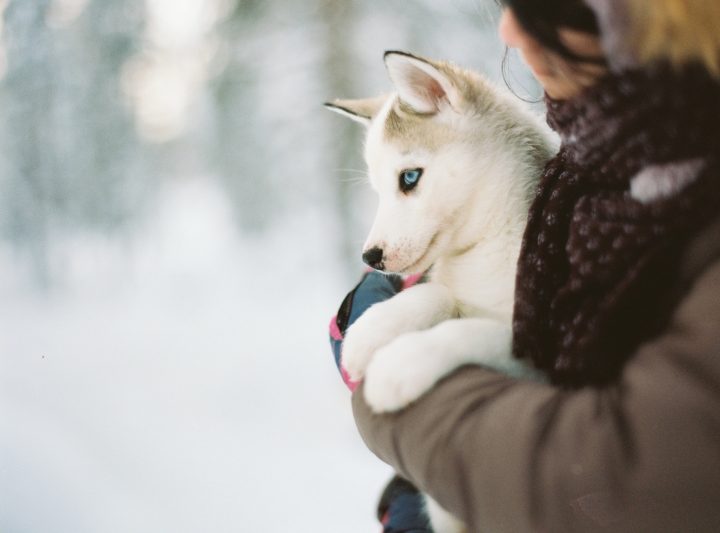
Table of Contents
- Why Do Puppies Have Blue Eyes?
- When Does the Puppy Eye Color Change Happen?
- Do Some Dogs Have Permanently Blue Eyes?
- Are Blue-Eyed Dogs More Prone to Health Problems?
- What Other Eye Colors Can Dogs Have?
- Do Some Dogs Just Have One Blue Eye?
- Watching Your Puppy Grow
- FAQ
Why Do Puppies Have Blue Eyes?
Are all puppies born with blue eyes? The answer here is yes.
The blue eye puppies are born with happens because of melanin. Melanin can be both a skin and an eye pigment, and it’s responsible for the deep brown eyes you see in most adult dogs.
Though puppies are known for their baby blues, their eyes are technically clear in color since they lack pigment. But thanks to eye structure and the refraction of light, their eyes appear blue to us.
The eye pigment melanin can take up to 12 weeks to fully settle in. Until then, you won’t be able to tell the permanent hue of your pup’s eyes.
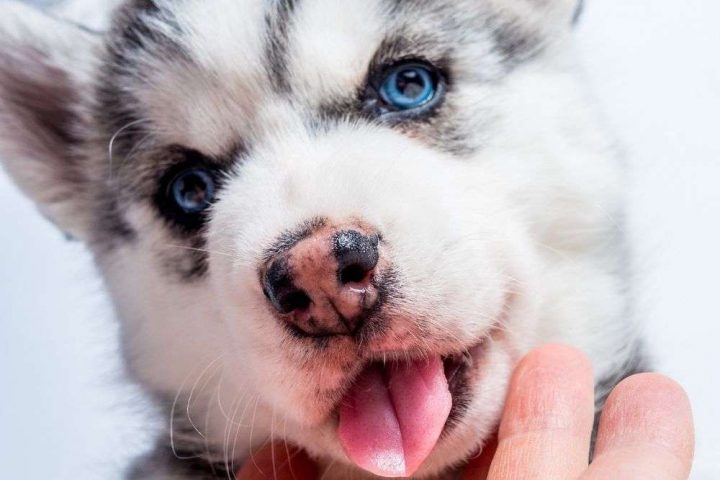
When Does the Puppy Eye Color Change Happen?
So when exactly do puppy eyes change color? Your puppy will usually have blue eyes up until about eight weeks of age. Starting around the age of nine weeks, your pup’s eyes will start to develop melanin. That development takes a few weeks, so you can usually expect your pup’s eyes to have changed to their permanent hue after about 12 weeks of age. In many cases, your puppy’s eyes will change to dark brown, the most common eye color in dogs who have fully matured.
It’s important to note that the puppy eye color change doesn’t happen overnight! It can take several weeks for melanin development to complete. But by eight or nine weeks, you might be able to get an idea of what your pup’s eye color will be when it’s fully developed.
Do Some Dogs Have Permanently Blue Eyes?
Blue puppy eyes are pretty enough that it’s easy to understand why someone would want a dog who has blue eyes permanently. And while it isn’t all that common, some dogs will grow up to have blue eyes.
Dogs with merle-colored coats are more likely to have eyes with blue as a permanent color. That’s because the merle gene causes pigment dilution. You can see this in a merle dog’s coat — it will appear dappled because random spots on the coat will be lighter.
The merle gene doesn’t just dilute the coat. Pigment dilution can happen on the eyes and nose, so many merle-colored dogs will have at least one blue eye. Here are some of the breeds where merle coloration is more common:
- Australian shepherds
- Border collies
- Dachshunds
- Cardigan Welsh corgis
- Catahoula leopard dogs
- Great Danes
Weimaraners are another breed where blue is a fairly common eye color (although greenish or amber eyes are also common). Similarly, adult pit bulls can sometimes have blue eyes.
If you really want a puppy with blue eyes that will stay blue, Siberian huskies are worth a look. Huskies are the dog breed most likely to have a permanent eye color of blue. That’s because they have a genetic mutation that reduces their eye pigmentation. The mutation, called ALX4, can be found on canine chromosome 18.
Even if you choose a husky, blue eyes aren’t guaranteed, though. Despite most of us picturing huskies with striking blue eyes, only about 40% of huskies grow up to have blue eyes! That’s still a much higher percentage than most dog breeds, though.
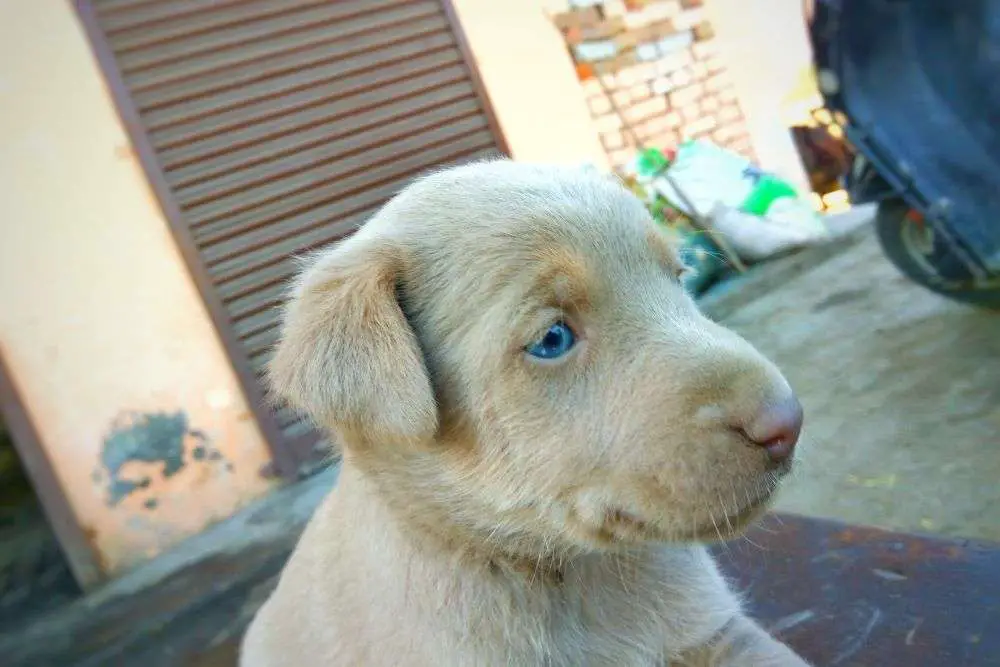
Are Blue-Eyed Dogs More Prone to Health Problems?
If the final color of your dog’s eyes is blue, that doesn’t mean that he will be prone to health issues. That concern may come down to the fact that in most dogs, blue eye color is a recessive trait. Recessive traits become more and more common if dogs are inbred, and many genetic health problems are linked to recessive genes. So when people see one recessive trait being expressed, they will naturally worry about others.
However, most dogs with blue eyes aren’t inbred, and responsible breeders will take potential health problems into account when selecting mates for their dogs. So if the permanent color of your dog’s eyes appears to be blue, there’s no cause for alarm.
But there are a few things to look out for when it comes to health and blue eyes:
Double Merles
One thing to watch out for when it comes to blue eyes and health problems is the breeding of merle dogs. It can be tempting to breed two merle dogs together, as that guarantees that all puppies will be merle. This beautiful and unique color is pretty popular, and it’s easy to see why.
However, in a litter where both parents are merle, 25% of the puppies will usually inherit what is known as double merle coloring. Though these dogs will usually have blue eyes, they also typically will have vision and hearing issues. In many cases, they will be entirely blind and/or deaf.
Since the health issues associated with double merle coloring have such an impact on a dog’s quality of life, many kennel clubs forbid the registration of puppies born from two merle parents.
Though the only way to be 100% sure that your dog is a double merle is to see his genetic profile, his coloring can give you a clue. If your pup is almost all white with some merle patches and blue eyes, he may well have the double merle gene.
Eye Color and Illness
If your dog is fully matured and his eyes suddenly appear to turn blue, he’s likely to have a health problem. For example, if your dog’s eyes start to appear blue and cloudy, he may be developing cataracts. This is especially likely if the change happens later in your dog’s life. Canine hepatitis will also make the corneas look bluish.
If your dog’s eyes change color (especially if they change to a foggy shade of blue) and he’s a good bit older than 12 weeks, be sure to seek professional advice. Your veterinarian will be able to examine your pet and give him treatment if anything is amiss.
Albinism
Albinism is a condition where there is no melanin produced throughout a dog’s body. An albino dog will have a white coat color with blue eyes. Though this combination may be lovely, it can pose some serious health concerns for the dog.
In many animals, individuals with albinism are more likely to be deaf. That’s because the lack of pigment in the ear canal will cause degeneration in the nerve endings. Over time, that means that the animal may not be able to hear. Fortunately, albinism in dogs is very rare. And for those hoping for a dog with a white coat color, the good news is that many dogs have white fur without also having albinism.
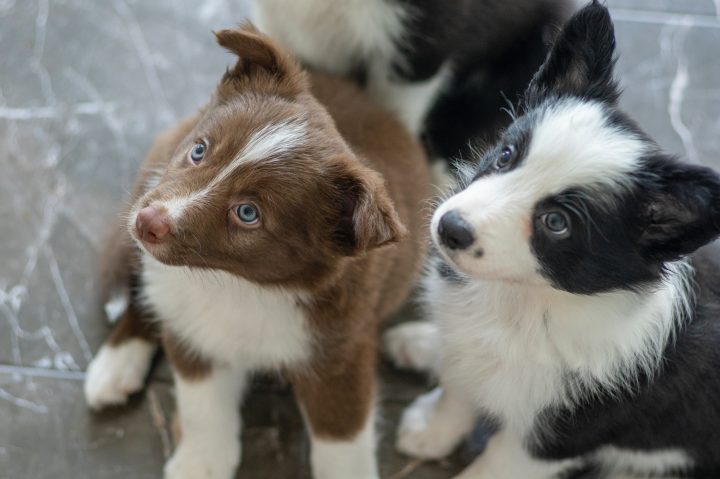
What Other Eye Colors Can Dogs Have?
Now that you know the answer to the question “are all dogs born with blue eyes?” you might be wondering if an adult dog can have green eyes, amber eyes, or really any any color besides brown or blue.
The most common eye color in dogs is definitely dark brown. However, there are some other eye colors you might run into:
- Green eyes – Like the bluish eyes puppies are born with, green eyes in adult dogs are a bit of an optical illusion. With this color, there is just a tiny bit of brown pigmentation. When that pigment is combined with the bluish color of refracting light, it will make your dog’s eye color look brown.
- Hazel eyes – This is a light brown color, though the exact shade may vary.
- Gold eyes – This eye color approaches being yellow. It’s more common in dogs with a liver or chocolate coat color.
- Amber eyes – This is the lightest shade of brown eye color for dogs. The next lightest shade would probably be gold.
- Speckled eyes – While dogs can have brown or green eyes much like people, they also will occasionally have speckled eyes! Though this is definitely not the most common eye color, it’s certainly beautiful and unique.
Generally speaking, dogs with darker coats are more likely to have darker eyes, while dogs with light coats are more likely to have lighter eyes. But the only way to really know what color your puppy’s eyes will be is to wait until he’s fully developed.
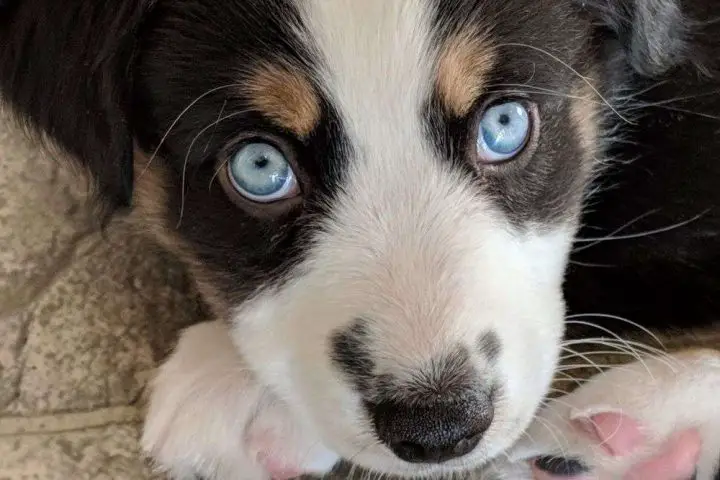
Do Some Dogs Just Have One Blue Eye?
For dog owners, watching a dog’s eyes change color can be exciting. And sometimes, you might see that your pup’s eyes are turning two different shades. This is something called heterochromia. In most cases, the permanent color of the eyes of a dog with heterochromia is usually one blue eye and one brown eye.
Having two different colored eyes is usually nothing to worry about from a health standpoint, you shouldn’t have to worry about your dog’s vision or hearing. Though still rare, heterochromia is a more common eye color in certain breeds. Here are some of the dog breeds that are more prone to heterochromia:
- Dalmatians
- Australian shepherds
- Border collies
- Australian cattle dogs
- Dachshunds
- Shih Tzus
- Chihuahuas
- Siberian huskies
- Shetland sheepdogs
- Great Danes
- Catahoula leopard dogs
Watching Your Puppy Grow
Why do puppies have blue eyes? Now that you know the answer, we hope you’re excited about watching your puppy’s eye color change once he’s several weeks old. Even if you’re hoping for a blue-eyed dog, a dog with dark brown eyes will be just as lovable!
FAQ
Still have some questions about the puppy eye color change? Here are a few of the most commonly asked questions:
There’s no surefire way to tell what color your puppy’s eyes will be before the color change happens. However, if you look at the parents, you may get a better idea of the possibilities. Puppies with lighter coats are also more likely to have blue eyes when fully mature.
The best way to tell if a puppy’s eyes will stay blue is to consider your dog’s genetics. Most breeds will grow up to have brown eyes. But if one or more of your puppy’s parents has blue eyes, your pup might grow up to have blue eyes, too! Because blue eye color seems to be connected to the merle gene, merle puppies are more likely to have blue eyes as adults as well.
Most of the time, yes. Most dog breeds have brown eyes. But some breeds including Siberian huskies, malamutes, pit bulls, Australian shepherds, and Weimaraners are more likely to have different-colored eyes




